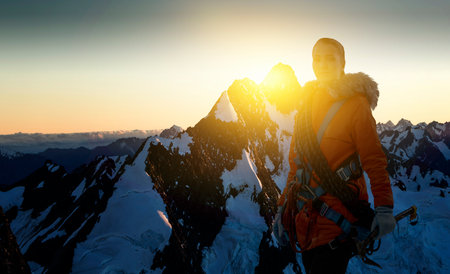Introduction to Peak Bagging in the UK
Peak bagging has long been woven into the fabric of British outdoor culture, capturing the imagination of walkers and mountaineers alike. This cherished tradition involves summiting a defined list of notable hills, fells, or mountains—each with its own storied past and regional character. From the rugged Munros of Scotland to the historic Wainwrights of the Lake District, peak bagging is not only a test of endurance but also an invitation to experience the UKs diverse landscapes through all four seasons. The terminology is steeped in local heritage: “bagging” refers to successfully reaching a summit, while phrases like “Munroist” or “Compleater” celebrate those who have conquered entire lists. Seasonality plays a crucial role in shaping each adventure; crisp winter air can transform familiar trails into challenging snow-capped ascents, while spring and summer reveal vibrant flora and expansive views. For many Britons, seasonal summit walks are more than just physical challenges—they are journeys that foster camaraderie, connect participants with nature’s rhythm, and uphold a rich legacy of exploration.
2. Top Peaks by Season: Where and When to Go
When it comes to bagging Britain’s iconic summits, timing is everything. The UK’s diverse landscape offers unique peak-bagging opportunities throughout the year, but each season presents its own set of challenges and rewards. For those keen to maximise safety, enjoyment, and scenic value, careful planning is essential. Here’s a guide to the best times for tackling some of England, Scotland, and Wales’ most celebrated peaks.
| Season | Peak | Location | Best Time to Visit | Highlights & Considerations |
|---|---|---|---|---|
| Spring | Helvellyn | Lake District, England | March–May | Breathtaking wildflowers on lower slopes; avoid snow on Striding Edge in early spring; longer daylight hours make for safer traverses. |
| Summer | Ben Nevis | Highlands, Scotland | June–August | Milder temperatures and clearer paths; summit views less likely to be clouded; crowds expected—early start recommended. |
| Autumn | Snowdon (Yr Wyddfa) | Snowdonia, Wales | September–October | Spectacular autumnal colours; fewer hikers than summer; weather can be changeable—pack waterproofs and layers. |
| Winter | Penyfan | Brecon Beacons, Wales | December–February | Crisp air with panoramic visibility on clear days; icy conditions require proper kit and caution; shorter routes advisable. |
| Year-round (weather permitting) | Scafell Pike | Lakeland Fells, England | Flexible—avoid after heavy rain or snowmelt for safest conditions. | The highest point in England; best attempted during settled weather regardless of season; always check mountain forecasts. |
Essential Planning Tips for Every Season:
Spring and Autumn:
- Navigational Skills: Weather can change rapidly—map reading is crucial.
- Keen Observation: Watch out for lingering snow patches in spring or slippery leaves in autumn.
Summer:
- Avoid Crowds: Start early to beat both heat and busy trails.
- Hydration: Carry sufficient water as some routes have limited sources.
Winter:
- Kitting Up: Microspikes or crampons may be necessary; always pack extra layers.
- Shorter Days: Plan for reduced daylight and allow contingency time for your descent.
No matter the season, always respect local advice, check up-to-date weather forecasts, and prepare appropriately for mountain conditions. Each peak offers a distinctive experience depending on when you visit—a thoughtful approach ensures you capture the very best of Britain’s majestic high points all year round.

3. Essential Gear and Local Know-How
Walking the UK’s peaks is a year-round adventure, but British weather is famously unpredictable. Having the right kit and a sound understanding of local practices can make all the difference between a memorable day out and an uncomfortable ordeal. Here’s what every summit-bagger should know before setting off.
Kit Requirements for British Weather
The key to successful walking in the UK is layering. Start with a moisture-wicking base layer, add an insulating mid-layer, and always bring a waterproof outer shell—Gore-Tex or similar fabrics are highly recommended. Good-quality walking boots with reliable grip are essential; conditions can change rapidly, especially on higher ground. Don’t forget a hat, gloves, and spare socks, even in summer—a sudden squall or temperature drop is never far away.
Navigation Essentials
British summits are notorious for mist and low visibility. Always carry an Ordnance Survey map of the area (paper maps still outperform digital alternatives when batteries fail), and know how to use a compass. GPS devices and smartphone apps are helpful but should be considered as backups rather than primary tools. Plan your route in advance and inform someone of your expected timings—mountain rescue teams respond best when they have accurate information.
Local Etiquette: Respecting the Land and Community
The UK’s uplands are shaped by centuries of human activity, farming, and conservation efforts. Stick to established paths where possible to minimise erosion, close gates behind you, and keep dogs under control during lambing season or where livestock graze. Greet fellow walkers with a friendly nod or “morning” – it’s customary on the hills. Finally, take all litter home; many rural areas lack bins, and leaving waste can harm wildlife and spoil these special places for others.
By preparing properly for the elements, navigating confidently, and following local etiquette, you’ll not only enjoy safer summit walks but also earn the respect of fellow outdoor enthusiasts across Britain’s iconic landscapes.
Leadership in the Hills: Group Walks and Guiding
Organising and leading group walks across the UKs varied peaks is both a privilege and a responsibility. The role of a walk leader extends beyond navigation; it encompasses safeguarding participants, fostering an inclusive atmosphere, and ensuring each member experiences the best of seasonal summit walking. Whether you are guiding a team up Scafell Pike or orchestrating a circuit around Snowdon, effective leadership is essential for a rewarding and safe adventure.
Essential Safety Protocols
Prioritising safety is non-negotiable when venturing into Britain’s unpredictable uplands. Leaders must conduct thorough pre-walk briefings, weather checks, and kit inspections. Below is a quick reference table outlining core safety responsibilities:
| Protocol | Description | Best Practice |
|---|---|---|
| Weather Assessment | Monitor Met Office reports prior to departure | Adapt plans if severe weather is forecasted |
| Kit Checks | Ensure all participants have suitable clothing, boots, and gear | Issue checklist ahead of time; check essentials on the day |
| Emergency Procedures | Prepare for accidents or incidents on the hill | Carry first aid kit, map, compass, and charged phone; know local Mountain Rescue contacts |
| Pace Setting & Headcounts | Regularly check group numbers and maintain manageable pace for all abilities | Nominate back marker; regroup at key points |
The Responsibilities of Leadership
A leader’s duties go well beyond logistics. It involves route planning that considers the season’s challenges—icy ridges in winter or boggy trails in spring—and ensuring everyone feels valued regardless of experience. Be decisive but approachable, ready to adapt routes or split groups if needed for safety or morale. Communication is paramount; keep your team informed about progress, breaks, and any hazards ahead.
Fostering Camaraderie and Team Spirit
The heart of any successful group walk lies in camaraderie. Encouraging mutual support transforms challenging climbs into shared triumphs. Foster inclusivity by rotating roles (such as map reading), celebrating milestones (like a first summit bagged), and nurturing a culture where everyone feels empowered to contribute or speak up. This not only strengthens the group dynamic but also ensures that every participant leaves with lasting memories from their year-round peak-bagging adventures.
5. After the Ascent: British Summit Traditions
Reaching a summit in the UK is more than just a physical achievement—it is a celebration of local culture and camaraderie that walkers across Britain cherish all year round. Whether you have scaled the snow-capped peaks of Scotland in winter or enjoyed a sun-dappled stroll up an English fell in summer, certain time-honoured traditions are woven into every summit experience.
Capturing the Moment: Trig Point Photos
No British summit walk feels complete without the classic photograph beside a trig point. These concrete pillars, relics of the Ordnance Survey’s mapping efforts, are now iconic markers at many of the UK’s highest spots. Walkers of all ages pause here for a quick snap—often with windswept hair and beaming smiles—commemorating both their journey and the ever-changing British weather.
The Ritual of Sharing a Flask
After hours on the trail, few pleasures compare to sharing a steaming flask of tea at the top. This quintessentially British gesture goes beyond refreshment; it’s about warmth, connection, and tradition. Some walkers opt for coffee or even hot chocolate, but whatever the brew, passing around a flask fosters conversation and reflection as everyone soaks in panoramic views from Snowdon to Scafell Pike.
Celebratory Drinks and Toasts
For many, the true celebration begins once boots are off and backpacks downed. Local pubs near popular trailheads bustle with hikers raising a well-earned pint—often of locally brewed ale—to toast their accomplishment. In Scotland, it might be a dram of whisky; in Wales, perhaps a cask ale or cider. This post-walk ritual is as much about storytelling and bonding as it is about refreshment.
Summit Logs and Shared Memories
Some summits feature logbooks tucked inside weatherproof boxes or cairns. Signing your name and jotting a few words alongside those who came before you has become another beloved custom, fostering a sense of community among hillwalkers across generations. These small acts—photographs, shared drinks, heartfelt entries—combine to create lasting memories and affirm why summit walks hold such enduring appeal throughout every season in Britain.
6. Protecting Britain’s Uplands: Responsible Walking
As we traverse the UK’s iconic peaks throughout the seasons, it is vital to remember that our enjoyment comes with a responsibility to protect these remarkable landscapes for future generations of summit seekers. Adhering to the Principles of Leave No Trace is fundamental for anyone keen on hillwalking or peak bagging. These guidelines encourage us to minimise our impact: always stick to established paths, avoid disturbing wildlife, and take all litter home—even biodegradable items can harm fragile upland ecosystems.
The Importance of Conservation
Britain’s uplands are not only places of adventure; they’re also habitats for rare flora and fauna, carbon stores, and precious water sources. Overuse or careless behaviour can lead to erosion, loss of biodiversity, and long-term environmental damage. By practising responsible walking—such as keeping dogs under control during lambing season and respecting any temporary path diversions—we help preserve these areas’ natural beauty and ecological health.
Supporting Local Initiatives
Many national parks and local communities run conservation projects aimed at repairing footpaths, restoring peat bogs, or rewilding degraded moorland. Consider supporting these efforts by volunteering your time or making a donation. Even small actions—like reporting damaged stiles or picking up stray rubbish—contribute to the ongoing care of our uplands.
A Legacy for Future Baggers
Ultimately, walking responsibly ensures that future generations will have the same opportunities to experience the thrill of cresting a misty ridge or admiring a wildflower-strewn fellside. By championing conservation and following best practice, we honour both the spirit of exploration and our duty as guardians of Britain’s treasured peaks.

